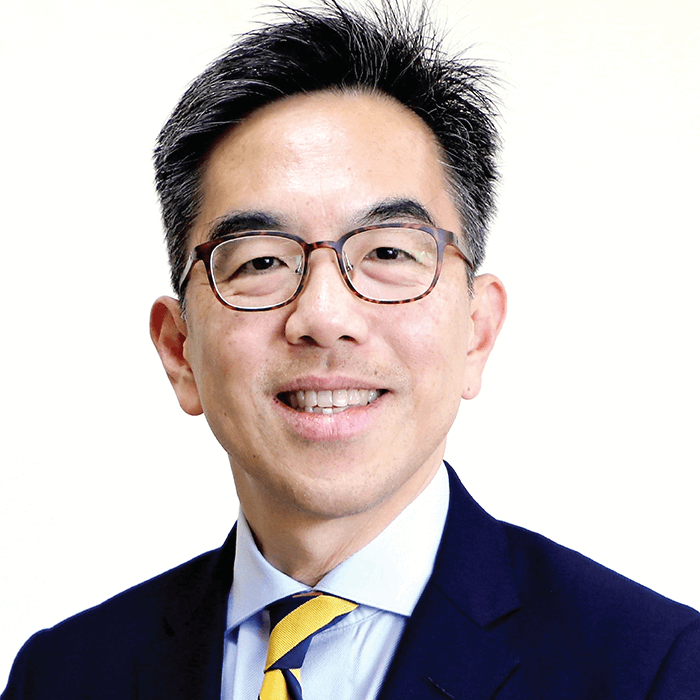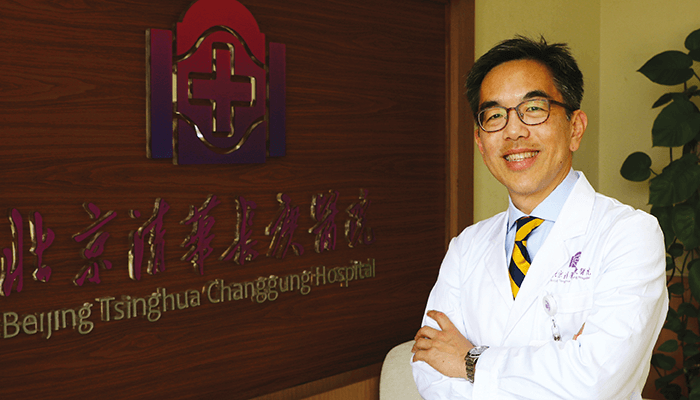
What has been your experience as an ophthalmologist in China?
I have been in China since the start of 2022 and have, over that time, been able to form an early impression of how ophthalmology is practised here. Working as an ophthalmologist in China means practising within a different structure and system to our compatriots elsewhere in the world. In other countries where I have trained and practised, such as the US, Singapore and Australia, the processes are relatively simple and, in some cases, similar. Patients initially go to either a GP or an optometrist with their conditions and are then referred to a specialist – the ophthalmologist. Although the exact specifics (such as differences in the availability and accessibility of public and private health systems) vary between countries, this stepwise process of moving from primary to secondary and potentially even tertiary care generally remains a constant.
In China, there are a number of differences. The first is that there is not a well-established system of GPs or optometrists – primary care is not a major part of the current Chinese healthcare ecosystem. This absence means that, when a Chinese patient has a problem, they have two routes to a solution: deal with it themselves using self-remedy or go to a major hospital. This is one of the reasons the COVID-19 pandemic was a challenge in China over the last, nearly three years; we had patients at the emergency room with little more than a cough or a cold because there is no easy “step” in between home care and the tertiary hospital. The current system means that somebody in China with any eye symptoms or ocular condition – even if relatively mild – will typically need to go to a large tertiary hospital with an ophthalmology department, where they will receive a comprehensive diagnosis, tests and treatment.
The second difference is that there is no regional health entity in the current Chinese healthcare system. In theory, patients in any city, county or province can choose to see a doctor anywhere else, as basic healthcare costs is covered by China’s national health insurance. Thus, instead of going to their city or local hospital, patients may be more inclined to choose ophthalmologists based on national reputation, and who they know and what information they have access to. This often leads to patients’ receiving fragmented rather than continuous care; they could have cataract surgery in one hospital and the follow-up in another, or treatment for age-related macular degeneration in one hospital with changes in treatment protocols or drugs in another due to a lack of satisfaction in the first hospital. It is not uncommon for me to see cases in which patients have already been seen by two or three other ophthalmologists and have brought a stack of medical notes with them, including their own OCT scans. In fact, I notice some ophthalmologists here seldom give fixed follow-up appointments to their patients due to the high possibility that the patient will go to another hospital next time. Though this fragmented care can work for more acute eye conditions or cataract surgery that require little long-term follow-up, for chronic eye conditions, such as glaucoma and retinal diseases, the lack of continuous care presents a problem.
The third difference is that Chinese ophthalmologists’ experience and training are highly heterogeneous, compared to Singapore or Australia where there are rigorous standards in ophthalmology residency training programs, so the clinical competency for the majority of ophthalmologists in these countries is relatively uniform. On the one hand, there are outstanding top Chinese eye surgeons who are true global experts at difficult and uncommon procedures such as complicated paediatric retinal surgeries. When word gets around that a particular surgeon is good, they get more of the same kinds of cases, meaning that some they perform these surgeries at incredibly high volumes that are hard to match elsewhere – making them some of the best the world has to offer. However, at the other end, there are also many ophthalmologists beyond 5 years into residency whose clinical acumen and skills one might consider less optimal, compared to similar residents I have supervised in Singapore and Australia. Part of this is due to the fact that the level and quality of training Chinese doctors receive varies massively depending on the hospital in which this training is provided. In the UK and US residency systems, once you have finished your training as a registrar, you have received a standard level of training, knowledge, and experience that equips you to be effective regardless of where you end up working; in China, such standardization protocols are still being refined. This lack of homogeneity and irregularity of training means that a lot of eyecare is concentrated within some of the major eye hospitals in the large cities, which are not sufficient to handle the 1.4 billion people in China who need appropriate and effective eye and healthcare in the areas they live.
One final difference that I find interesting is that Chinese hospitals increasingly have a lot of “national brand” devices that have been made in China, including OCT, wide-field imaging cameras and more. There are also of course drugs produced domestically. International or domestic drugs still need to navigate China’s National Medical Products Administration (NMPA) which oversees both new drugs and medical devices, but because of local companies, there is actually some competition for international drugs and devices to be in China’s market.
Tell us about your current role and the steps you’re taking to refine the Chinese healthcare system…
I joined Tsinghua University in Jan 2022 with a task to develop and set up an innovative, modern, internationally-focused, academic healthcare system within China based at Tsinghua. A key task is to facilitate an integrated partnership between the University’s different Schools and the University’s affiliated but largely independent hospitals, to promote research and innovation that can be translated into improved patient care. In this role, I’ve had three main areas of focus over the past year.
The first has been the reformation of medical education to include more scientific training in the curriculum. Traditional Chinese medical education is based on clinical practice; I have sought to shift this balance so that future medical students and doctors are trained in foundations of scientific research, evidence-based medicine and can evaluate scientific literature and conduct research studies of their own, enabling them to improve on existing practices.
My second area of focus has been increasing the volume of translational research by bringing scientists and doctors together to plug the gaps in the pipeline between the discovery of new ideas and their application in clinical care. Traditionally, we haven’t seen this happen as much as we’d like, especially when compared with other countries.
Our third aim is to shift our healthcare focus area by increasing our understanding of critical areas that are important for China in the future. We are looking to move away from the current system and structure of just depending on tertiary hospitals for healthcare, and toward more focus on primary and population health, and prevention rather than treatment. This will require engagement and elevation of public education, good personal healthcare and eye care habits, and encouraging patients to see the doctor before symptoms become severe to reduce the rates of late treatment. As part of this, we encourage patients to engage in regular precautionary check ups – such as yearly eye screens for people with diabetes. In particular, we want to educate China’s elderly population in China who, from our observations, are not as well informed about health problems as in the west.
How achievable do you think these goals are?
I believe setting clear goals and targets are important, but I am also aware that it will likely take decades to achieve these goals. I hope to implement a roadmap that leaders after me can follow and improve on. I have found the Chinese medical and ophthalmology community’s willingness and openness toward international ideas – without which I would not even be here – particularly encouraging. One of the many benefits to being a part of the global medical and ophthalmology community is seeing and engaging with what others are doing, adding to and taking from the pool of knowledge built up out of our individual successes and approaches. It is through this collaboration that we can grow our profession and ultimately provide better care to our patients.
I urge and encourage the international community to engage with Chinese ophthalmologists, to accept invitations to speak at Chinese events, and to take in and train Chinese residents and fellows, because the Chinese people are truly keen to learn and improve. In the beginning, there may be some growing pains borne of the differences between Chinese processes and systems, which are still evolving, and those of the rest of the world. Some Chinese ophthalmologists going abroad for training in more established sectors may require a little more understanding as a result of the different training standards – even if they have previously practised for an extended period of time in China. Likewise, sometimes communications and invitations to participate in Chinese forums and events may come at short notice because the less formal systems currently in place do not lend themselves to systematically planning events far in advance (unlike what we are used to internationally). However, from my experience, engaging with Chinese symposiums and forums, and working with Chinese ophthalmologists is truly rewarding for both parties.
Similarly, I have also encouraged our Chinese ophthalmologist colleagues to be active members of the global ophthalmic community. In the past, many Chinese ophthalmologists actively participated in international meetings such as AAO, ARVO, etc. I continue to encourage our Chinese friends to go abroad, re-acquaint with old friends and make new friends, share clinical ideas and experience and collaborative work with overseas colleagues. In the last three years, the COVID-19 pandemic has made it more difficult to establish and sustain such international connections, but I think it is very important that, even with new external pressures, Chinese ophthalmologists keep engaging with the world, participating, speaking and travelling to international events, and being part of the global ophthalmic community.
Global ophthalmology has benefited significantly from international collaboration over the years – something that we will lose if communities become siloed. China’s medical infrastructure and processes may still be developing, but I truly believe that, through both internal efforts and engagement with the international community, the results and relationships we can build will benefit ophthalmologists, researchers, and patients – not only in China, but across the globe.

